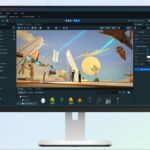Future of Industries: Key AI & XR Trends Driving 2025
AI became a strategic necessity driving industry advancement. Together with evolving hardware, it accelerates XR’s transition from innovation to mainstream adoption. As extended reality becomes more accessible, ecosystems are reshaping collaboration; AR is making a strong enterprise comeback, and on top of that synergistic partnerships fuel breakthrough innovations. This edition highlights the most impactful trends from the past year covered by Lucid Reality Lab’s experts, offering insights that enterprises can leverage to stay ahead in 2025.
1. The Rise of AI
Artificial intelligence has become an integral business partner, driving transformation across industries. As we discussed, in early 2024, the SORA rush and text-to-spatial AI unlocked capabilities once thought impossible, enabling businesses to create immersive product demos, virtual training environments, and real-time collaboration spaces.
As enterprises accelerate AI adoption, the focus is shifting from simple automation to enhancing creativity, personalization, and operational efficiency. For instance, Stargate, a $500 billion initiative, further reinforces this shift by providing the computational infrastructure needed to scale AI applications, making advanced technologies more accessible, adaptable, and impactful across industries in the USA. With these innovations, businesses aren’t just making workflows more efficient but unlocking new ways to collaborate, create, and make smarter decisions, allowing companies to enhance customer experiences, optimize operations, and drive innovation at scale, giving them a competitive advantage in an increasingly AI-driven business ecosystem. We consider AI the most powerful trend of the next few years and will keep updating you on key advancements.
2. Ecosystems Shaping the Business World
Effective business is no longer about isolated innovations in implementation but about ecosystems. Last year, Meta and Android XR have driven the movement toward integrated platforms, where hardware, software, and AI-powered systems work together seamlessly. The ecosystem approach will continue to evolve as it brings numerous benefits to all of its participants. Enterprises that position themselves within these ecosystems gain access to faster innovation cycles, more scalable solutions, and deeper integrations. For businesses, this means shifting from standalone products to connected, intelligent experiences that adapt and evolve with users.
3. Photorealistic Visual Fidelity, Seamless Experiential Design
Visual fidelity in XR has achieved photorealistic quality as a standard. This advancement is largely due to significant hardware improvements, such as NVIDIA’s Media2, which stands for the latest AI-powered initiative transforming content creation, streaming, and live media experiences.
In this respect, experiential design becomes increasingly crucial. Every interaction within XR environments—from navigating menus to manipulating virtual objects—must feel intuitive, natural, and engaging. Companies are investing in gesture-based controls, adaptive interfaces, and AI-driven personalization to create experiences that not only replicate the real world but also enhance it. For instance, NVIDIA CloudXR™ enables streaming of high-fidelity XR content to untethered devices. Lucid Reality Labs analyzed the market’s progress while developing our excellence in design for impact.
4. The AR Glasses Comeback: AI on the go
Just a few years ago, AR glasses seemed like an exciting idea that never quite took off. But in 2024, they made a major comeback, and this time, with practical applications that businesses can’t ignore. AR glasses are advancing enterprise operations, from hands-free remote assistance for field workers to real-time data visualization for decision-makers. Industries like manufacturing, logistics, training, and healthcare are embracing AR to improve efficiency, accuracy, and training effectiveness. As the hardware improves and software ecosystems expand, AR is quickly becoming an indispensable tool for enterprise professionals. Lucid Reality Labs conducted its own series of polls among tech professionals about the biggest challenges, must-have features, and key success metrics for AR glasses in the workplace. Check our insights!
5. Partnerships & Alliances: The Backbone of Innovation
The biggest breakthroughs in 2024 didn’t come from solo efforts but from strategic partnerships. Companies like NVIDIA, OpenAI, and Meta are proving that the future belongs to those who collaborate. By sharing R&D efforts, co-developing new technologies, and pooling expertise, businesses can accelerate innovation and reduce time-to-market for gamechanging solutions. For enterprises, the lesson is clear: find the right partners, align on vision, and leverage collective strengths to stay ahead.
Looking Ahead
These trends underscore a pivotal shift for enterprises—from passive adoption to proactive innovation. Whether by streamlining operations, creating more engaging experiences, or building stronger partnerships, companies that adapt quickly and embrace new opportunities will set the standard for success in 2025 and beyond.
Let’s shape the future, together!
Quelle:


